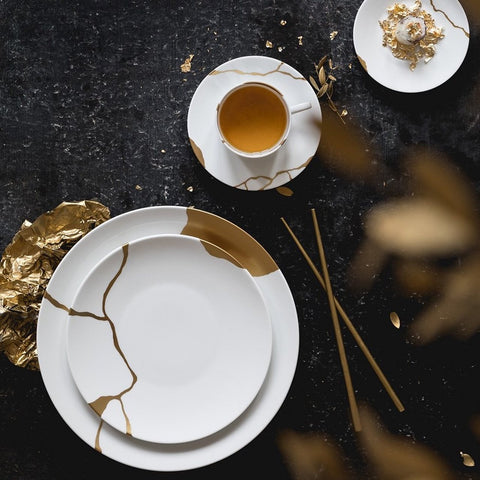
In a world that places youth, perfection, and flawlessness on a pedestal, embracing the old and broken is an unfamiliar concept. But the Japanese practice of kintsugi, meaning “golden joinery,” is a centuries-old art form involving the repair of pottery and other cherished objects with precious metals.

More than an aesthetic, for the Japanese, kintsugi is symbolic of a broader philosophy of celebrating the beauty in the imperfections that make us human.
As people, we wear our inner struggles, grief, and pain on the outside for the world to see. Like a badge of honor, our scars, wrinkles, and flaws are what make us unique. They are a roadmap to where we’ve been, who we are, and where we’re going— each of us perfectly imperfect in our own way.
But when our lives are in disrepair, the wreckage from our past can leave us feeling utterly shattered and irreparably damaged. Kintsugi teaches that like broken pottery, we can pick up the pieces of our lives and put them back together to create something better.
In a society that tells us to erase our lines, hide our age, and cover our flaws, this 500-year-old Japanese method celebrates what’s broken by highlighting imperfections instead of hiding them.

Embracing our flaws and the inevitable cracks in the road that come as we walk along life’s journey is a process that leads to a deeper sense of peace and fulfillment.

Far too many of us spend our lives hiding behind a mask, disguising the scars of our past. In a constant race to some mythical finish line, we worry that if we take time out of our busy day to care for ourselves that someone might catch and beat us in the race. This perpetual need to be perfect, be hard on ourselves, and cover up our fears builds up inside of us creating anger, sadness, and emptiness.
Never feeling that we’re ever quite “good enough,” we seek validation from outside and when we don’t receive it, we feel shattered.
Kintsugi teaches that it’s not only okay to hurt, grieve, and be vulnerable, but it’s okay to accept yourself for all that you are, cracks and all.

The Kintsugi technique
In Japanese art, the Kintsugi technique of mending ceramics with gold is relatively simple. It comes from the maki technique, a craft that uses golden lacquer as a repair medium.
Once the ceramic is broken, it is reassembled with the lacquer or resin, reattaching the broken pieces together with minimal overlap. Gold dust is then applied, which fixes to the lacquer, giving the break its golden hue.

The Wabi-sabi state of mind
The kintsugi technique is an extension of the Japanese philosophy of wabi-sabi which sees beauty in the incomplete and value in simplicity. In the practice of kintsugi, the gilded restoration usually takes up to three months, as the fragments are carefully glued together with the sap of an indigenous Japanese tree, left to dry for a few weeks, and then adorned with gold running along its cracks.
In an age of mass production and quick disposal, learning to revel in the ritual is a powerful lesson in sustainability.
While the term wabi-sabi cannot be literally translated into English, wabi refers to the loneliness of life in nature and a love for simple things and sabi designates tranquility, nostalgia, and the beauty that comes with time and old age.

Born out of a reaction to the lavishness and extravagance of the time, wabi-sabi is a Japanese aesthetic that embraces and celebrates beauty in imperfection, impermanence, asymmetry, incompleteness, and simplicity, with an appreciation for nature and its processes. Though the philosophy of wabi-sabi has received recently rewed notoriety on social media by those seeking a more simple, authentic, and calm lifestyle, its origins date back to 15th Century Japan.

The wabi-sabi aesthetic can best be illustrated in the tea ceremony, where the Japanese art of mending ceramics with gold was born.
Because the service of tea in Japan follows a set of rules and codes and requires patience, meticulous gestures, calm, and unfailing silence, it takes an experienced practitioner to perform this ceremony correctly.
Though each object in this ritualistic service has symbolic meaning, the ceramics used for the tea ceremony hold the most significance. Though unpretentious, modest, and humble, there is great intrinsic value in the simplicity of the ceramics used in the service of tea.
Unlike the throwaway mentality of modern western culture, if an object breaks, it will not be tossed in the trash. Honoring the history inherent in the cracks of the pottery, the object will be set aside and mended.

If an entire part of the ceramic is missing or completely broken, the craftsman might go so far as to take a piece from another ceramic, not necessarily matched, but similar in its shape. This piece is then assembled with the original ceramic with the golden lacquer, creating a patchwork effect.
The result is an object with even greater richness and a more inspiring story to tell.
This philosophy of wabi-sabi is the heart of kintsugi and is of utmost importance in Japanese culture and traditions, leading to a path to enlightenment. Even today, Japanese culture is filled with this wisdom of accepting the fatalities of existence and of honoring them.

Today, Kintsugi is celebrated around the world. Museums such as the Metropolitan Museum of Art in New York and the Smithsonian, have devoted exhibitions to the art of Kintsugi.
New York designer George Inaki Root, inspired by Japanese art, created a line of jewelry called Kintsugi, which incorporates the techniques from this tradition.

Inspired by the practices of Kintsugi, artist Victor Solomon created the Kintsugi Court on the south side of Los Angeles in 2020. Speaking to the social fractures at work in southern California inner-city neighborhoods, he used golden resin to repair a cracked basketball court, highlighting the role sports play in our collective healing process.

Transformative Teachings of the Art of Kintsugi
Being Kind to Yourself
The spirit of kintsugi is about acceptance and forgiveness. Accepting one’s imperfections allows us to be more loving and forgiving toward ourselves while letting go of resentments towards others is the first step towards inner peace.
As difficult as our struggles, pain, and loss might have been, once we realize that the most beautiful and meaningful parts of ourselves are the ones that have been broken, mended, and healed, we can discover a more beautiful and refined version of ourselves. With self-love, our cracks become golden.

Celebrating Progress, not Perfection
In a culture that encourages, celebrates, and honors perfection, we as humans tend to look for instant gratification in a race to the top. But rewards take persistence, hard work, and perseverance.
Giving ourselves permission to look closer at our tiny achievements and let go of unreasonable expectations allows us to live in the moment instead of fearing the past or worrying about the future.
When you celebrate your progress instead of striving for perfection, you’ll realize you are already right where you belong.

Remaining Teachable
Life is about learning and growing, from the moment we take our first breath to the instant we take our last. This is the key to kintsugi. Remaining open, willing, and honest with what you know and what you’ve yet to understand is necessary to find the gold in the mending. Eliminating the words “I know” from your vocabulary allows you to remain teachable and open to possibilities, allowing for space to grow.

Recognizing Imperfections Are Golden
Your harshest pains, deepest fears, and most difficult struggles have created the creases and crevices that have molded you into a unique being. Some cracks run deep; some are still in a state of repair, and many more have yet to be mended. And the path is not straight. In fact, it’s life’s twists and turns that pave the way to meaning, happiness, and fulfillment.

A metaphor for reconstruction, renewal, and growth, the Japanese art of mending ceramics with gold represents healing, introspection, and the indomitable resilience of the human spirit.
by Eileen Honey Strauss.

